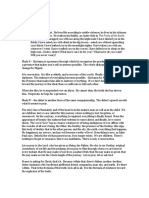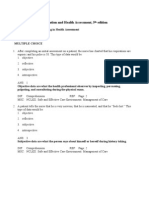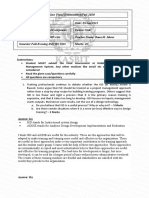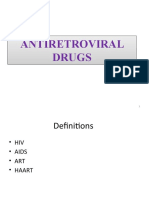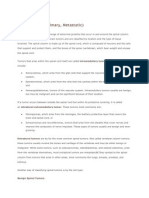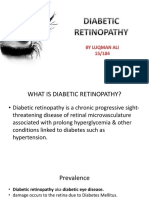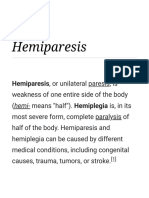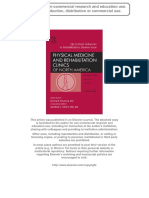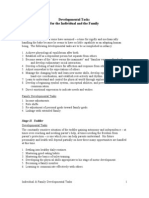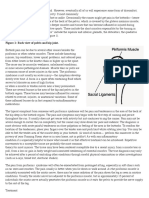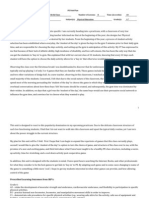Classification of Burns
Classification of Burns
Uploaded by
Mauricio SvCopyright:
Available Formats
Classification of Burns
Classification of Burns
Uploaded by
Mauricio SvCopyright
Available Formats
Share this document
Did you find this document useful?
Is this content inappropriate?
Copyright:
Available Formats
Classification of Burns
Classification of Burns
Uploaded by
Mauricio SvCopyright:
Available Formats
28/01/13
Classification of burns
Official reprint from UpToDate www.uptodate.com 2013 UpToDate
Classification of burns Authors Phillip L Rice, Jr, MD Dennis P Orgill, MD, PhD Disclosures All topics are updated as new evidence becomes available and our peer review process is complete. Literature review current through: Dec 2012. | This topic last updated: ago 29, 2012. INTRODUCTION A burn is defined as a traumatic injury to the skin or other organic tissue primarily caused by thermal or other acute exposures. Burns occur when some or all of the cells in the skin or other tissues are destroyed by heat, cold, electricity, radiation, or caustic chemicals. Burns are acute wounds caused by an isolated, non-recurring insult and progress rapidly through an orderly series of healing steps [1]. The most common types of burns and their classification will be reviewed here. The clinical assessment, potential acute complications, and management of moderate and severe burns in adults and children, minor burns, and other related injuries are discussed elsewhere. (See "Emergency care of moderate and severe thermal burns in adults" and "Emergency care of moderate and severe thermal burns in children" and "Treatment of minor thermal burns" and "Smoke inhalation" and "Environmental electrical injuries".) TYPES OF BURNS The most common type of burn in children is from a scald injury; in adults, the most common burn occurs from a flame. The following is a list of the types of burns that may be incurred by adults and children. Thermal The depth of the burn injury is related to contact temperature, duration of contact of the external heat source, and the thickness of the skin. Because the thermal conductivity of skin is low, most thermal burns involve the epidermis and part of the dermis [2]. The most common thermal burns are associated with flames, hot liquids, hot solid objects, and steam. The depth of the burn largely determines the healing potential and the need for surgical grafting. (See "Emergency care of moderate and severe thermal burns in adults".) Cold exposure (frostbite) Damage occurs to the skin and underlying tissues when ice crystals puncture the cells or when they create a hypertonic tissue environment. Blood flow can be interrupted, causing hemoconcentration and intravascular thrombosis with tissue hypoxia. (See "Frostbite".) Chemical burns Injury is caused by a wide range of caustic reactions, including alteration of pH, disruption of cellular membranes, and direct toxic effects on metabolic processes. In addition to the duration of exposure, the nature of the agent will determine injury severity. Contact with acid produces tissue coagulation, while alkaline burns generate colliquation necrosis. Systemic absorption of some chemicals is life threatening. (See "Topical chemical burns".) Electrical current Electrical energy is transformed into thermal injury as the current passes through poorly conducting body tissues. Electroporation (injury to cell membranes) disrupts membrane potential and function. The magnitude of the injury depends on the pathway of the current, the resistance to the current flow through the tissues, and the strength and duration of the current flow. (See "Environmental electrical injuries".) Inhalation Toxic products of combustion injure airway tissues and frequently occur with flash burns from fire and steam. Hot smoke usually burns only the pharynx while steam can also burn the airway below the glottis. Many toxic chemicals produced in fires injure the lower airways with chemical burns. Carbon monoxide, which is produced from combustion, impairs cellular respiration. (See "Smoke inhalation".) Radiation burns Radio frequency energy or ionizing radiation can cause damage to skin and tissues. The most common type of radiation burn is the sunburn. Depending on the photon energy, radiation can cause very
www.uptodate.com/contents/classification-of-burns?topicKey=SURG%2F819&elapsedTimeMs=1&source=search_result&searchTerm=burn&selectedTitl 1/16
Section Editor Marc G Jeschke, MD, PhD
Deputy Editor Rosemary B Duda, MD, MPH, FACS
28/01/13
Classification of burns
deep internal burns. Radiation burns are often associated with cancer due to the ability of ionizing radiation to interact with and damage DNA. The clinical results of ionizing radiation depend on the dose, time of exposure, and type of particle that determines the depth of exposure. It is advisable for medical facilities to develop, test, and implement an action plan for emergency preparedness in advance of a potential disaster from radiation exposure [3]. (See "Biology and clinical features of radiation injury in adults" and "Clinical features of radiation exposure in children".) Associated injuries Events that are associated with a burn may cause other injuries, such as fractures. Burns in the elderly and children may also be associated with abuse. (See "Physical abuse in children: Epidemiology and clinical manifestations", section on 'Burns' and "Elder mistreatment: Abuse, neglect, and financial exploitation".) CLASSIFICATION Cutaneous burns are classified according to the depth of tissue injury: superficial or epidermal (first-degree), partial-thickness (second degree), or full thickness (third degree). Burns extending beneath the subcutaneous tissues and involving fascia, muscle and/or bone are considered fourth degree (table 1). Burn wounds are not usually uniform in depth and many have a mixture of deep and superficial components. A precise classification of the burn wound may be difficult and may require up to three weeks for a final determination [4,5]. Thin skin, particularly on the volar surfaces of the forearms, medial thighs, perineum, and ears, sustains deeper burn injuries than suggested by initial appearance [5]. It is best to assume there are no shallow burns in these areas [6]. Children under the age of five and adults over the age of 55 are also more susceptible to deeper burns because of thinner skin [5,6]. Appropriate burn wound care may necessitate multiple treatment modalities for different parts of a burn wound depending on the burn depth of each injured part. In 2009, the American Burn Association (ABA) published an educational resource that reviewed the classification and management of the burn wound. The classification system below is largely in agreement with the on-line ABA publication (www.ameriburn.org) [1]. Burn depth The traditional classification of burns as first, second, third, or fourth degree was replaced by a system reflecting the need for surgical intervention. Current designations of burn depth are superficial, superficial partial-thickness, deep partial-thickness, and full-thickness (table 1 and figure 1) [4]. The term fourth degree is still used to describe the most severe burns, burns that extend into the muscle, bone, and/or joints. Superficial Superficial or epidermal burns involve only the epidermal layer of skin. They do not blister but are painful, dry, red, and blanch with pressure (picture 1). Over the next two to three days the pain and erythema subside, and by about day four, the injured epithelium peels away from the newly healed epidermis. Such injuries are generally healed in six days without scarring. This process is commonly seen with sunburns. Partial-thickness Partial thickness burns involve the epidermis and portions of the dermis. They are characterized as either superficial or deep. Superficial - These burns characteristically form blisters within 24 hours between the epidermis and dermis. They are painful, red, and weeping, and blanch with pressure (picture 2). Burns that initially appear to be only epidermal in depth may be determined to be partial-thickness 12 to 24 hours later. These burns generally heal in 7 to 21 days; scarring is unusual, although pigment changes may occur. A layer of fibrinous exudates and necrotic debris may accumulate on the surface, which may predispose the burn wound to heavy bacterial colonization and delayed healing. These burns typically heal without functional impairment or hypertrophic scarring. Deep - These burns extend into the deeper dermis and are characteristically different from superficial partial-thickness burns. Deep burns damage hair follicles and glandular tissue. They are painful to pressure only, almost always blister (easily unroofed), are wet or waxy dry, and have variable mottled colorization from patchy cheesy white to red (picture 3). They do not blanch with pressure.
www.uptodate.com/contents/classification-of-burns?topicKey=SURG%2F819&elapsedTimeMs=1&source=search_result&searchTerm=burn&selectedTitl 2/16
28/01/13
Classification of burns
If infection is prevented and wounds are allowed to heal spontaneously without grafting, they will heal in three to nine weeks. These burns invariably cause hypertrophic scarring. If they involve a joint, joint dysfunction is expected even with aggressive physical therapy. A deep partial-thickness burn that fails to heal in three weeks is functionally and cosmetically equivalent to a full thickness burn. Differentiation from full-thickness burns is often difficult. Full-thickness These burns extend through and destroy all layers of the dermis and often injure the underlying subcutaneous tissue. Burn eschar, the dead and denatured dermis, is usually intact. The eschar can compromise the viability of a limb or torso if circumferential. Full thickness burns are usually anesthetic or hypoesthetic. Skin appearance can vary from waxy white to leathery gray to charred and black. The skin is dry and inelastic and does not blanch with pressure (picture 4). Hairs can easily be pulled from hair follicles. Vesicles and blisters do not develop. Pale full-thickness burns may simulate normal skin except that the skin does not blanch with pressure. Features that differentiate partial-thickness from full-thickness burns may take some time to develop. The eschar eventually separates from the underlying tissue and reveals an unhealed bed of granulation tissue. Without surgery, these wounds heal by wound contracture with epithelialization around the wound edges. Scarring is severe with contractures; complete spontaneous healing is not possible. Fourth degree burns Fourth degree burns are deep and potentially life-threatening injuries that extend through the skin into underlying tissues such as fascia, muscle, and/or bone. PERCENT BODY SURFACE AREA ESTIMATES A thorough and accurate estimation of burn size is essential to guide therapy and to determine when to transfer a patient to a burn center. In several observational reports comparing the estimation of burn size at the referring hospital with the estimation at the receiving burn center, the size of larger burns was underestimated. This resulted in underresuscitation at the referring hospital [7-9]. Early transfer to a burn center should be arranged when injuries meet the criteria for major burns (table 2). (See "Emergency care of moderate and severe thermal burns in adults", section on 'Initial interventions'.) The extent of burns is expressed as the total percentage of body surface area (TBSA). Superficial burns are not included in the TBSA burn assessment. The location of partial-thickness and full-thickness burned areas are recorded on a burn diagram (figure 2). Burns with an appearance compatible with either deep partial-thickness or full-thickness are presumed to be full-thickness until accurate differentiation is possible. The two commonly used methods of assessing TBSA in adults are the Lund-Browder chart and "Rule of Nines," whereas in children, the Lund-Browder chart is the recommended method because it takes into account the relative percentage of body surface area affected by growth. When the burn is irregular and/or patchy, the palm method may be useful. Lund-Browder The Lund-Browder chart is the most accurate method for estimating TBSA for both adults and children. It takes into account the relative percentage of body surface area affected by growth (figure 2) [4,10,11]. Children have proportionally larger heads and smaller lower extremities, so the percentage BSA is more accurately estimated using the Lund-Browder chart (table 3 and figure 2). Rule of Nines For adult assessment, the most expeditious method to estimate TBSA in adults is the "Rule of Nines" [12,13]: Each leg represents 18 percent TBSA Each arm represents 9 percent TBSA The anterior and posterior trunk each represent 18 percent TBSA The head represents 9 percent TBSA Palm method Small or patchy burns can be approximated by using the surface area of the patient's palm. The palm of the patient's hand, excluding the fingers, is approximately 0.5 percent of total body surface area and the entire palmar surface including fingers is 1 percent in children and adults [14-16].
www.uptodate.com/contents/classification-of-burns?topicKey=SURG%2F819&elapsedTimeMs=1&source=search_result&searchTerm=burn&selectedTitl 3/16
28/01/13
Classification of burns
Anterior chest wall burns in women The percent of total body surface area (TBSA) burned may be underestimated in women with burns of the anterior trunk and large breasts. A table based on the cup size of a brassiere is intended to complement the Lund and Browder chart for burn estimation in adults. In a review of 60 volunteers to determine the difference in TBSA of the anterior trunk between men and women, large breasted women (cup size D and greater) were found to have a significantly greater amount of TBSA on the anterior chest in comparison to men (16 versus 11 percent) [17]. This additional TBSA is concentrated on the pectoral region, and represents 10 percent of TBSA as compared to 5 percent for men and 7 percent for women with smaller breasts. There was an equal distribution of anterior and posterior trunk TBSA in men, but a 1.6 to 1 ratio in large breasted women. For every increase in cup size, the TBSA of a womans anterior trunk increases by a factor of 0.1, relative to the posterior trunk (figure 3). (See 'Percent body surface area estimates' above.) SUMMARY A burn is defined as a traumatic injury to the skin or other organic tissue primarily caused by thermal or other acute exposures. (See 'Introduction' above.) Cutaneous burns are classified according to the depth of tissue injury. (See 'Classification' above.) A thorough estimation of burn size is essential to guide therapy. The extent of burns is expressed as the total percentage of body surface area (TBSA). (See 'Percent body surface area estimates' above.) The estimation of percent total body surface area includes partial-thickness, full-thickness, and fourth degree burns. Superficial burns are not included in the TBSA burn assessment. (See 'Percent body surface area estimates' above.) The most accurate method of assessment of TBSA burn in children and adults is the Lund-Browder chart. (See 'Lund-Browder' above.)
Use of UpToDate is subject to the Subscription and License Agreement. REFERENCES 1. American Burn Association White Paper. Surgical management of the burn wound and use of skin substitutes. Copyright 2009. www.ameriburn.or (Accessed on January 04, 2010). 2. Orgill DP, Solari MG, Barlow MS, O'Connor NE. A finite-element model predicts thermal damage in cutaneous contact burns. J Burn Care Rehabil 1998; 19:203. 3. Wolbarst AB, Wiley AL Jr, Nemhauser JB, et al. Medical response to a major radiologic emergency: a primer for medical and public health practitioners. Radiology 2010; 254:660. 4. Mertens DM, Jenkins ME, Warden GD. Outpatient burn management. Nurs Clin North Am 1997; 32:343. 5. Baxter CR. Management of burn wounds. Dermatol Clin 1993; 11:709. 6. Pham, TN, Girban, NS, Heimbach, DM. Evaluation of the burn wound: Management decisions. In: Total Burn Care, 3rd edition, Herndon, D (Eds), Saunders Elsevier, Philadelphia 2007. p.119. 7. Collis N, Smith G, Fenton OM. Accuracy of burn size estimation and subsequent fluid resuscitation prior to arrival at the Yorkshire Regional Burns Unit. A three year retrospective study. Burns 1999; 25:345. 8. Hagstrom M, Wirth GA, Evans GR, Ikeda CJ. A review of emergency department fluid resuscitation of burn patients transferred to a regional, verified burn center. Ann Plast Surg 2003; 51:173. 9. Freiburg C, Igneri P, Sartorelli K, Rogers F. Effects of differences in percent total body surface area estimation on fluid resuscitation of transferred burn patients. J Burn Care Res 2007; 28:42. 10. Woodson, LC, Sherwood, ER, Aarsland, A, et, al. Anesthesia for burned patients. In: Total Burn Care, 3rd edition, Herndon, DN (Eds), Saunders Elsevier, Philadelphia 2007. p.196. 11. Lund CC, Browder NC. The estimation of areas of burns. Surg Gynecol Obstet 1944; 79:352. 12. Monafo WW. Initial management of burns. N Engl J Med 1996; 335:1581. 13. Wachtel TL, Berry CC, Wachtel EE, Frank HA. The inter-rater reliability of estimating the size of burns
www.uptodate.com/contents/classification-of-burns?topicKey=SURG%2F819&elapsedTimeMs=1&source=search_result&searchTerm=burn&selectedTitl 4/16
28/01/13
Classification of burns
from various burn area chart drawings. Burns 2000; 26:156. 14. Perry RJ, Moore CA, Morgan BD, Plummer DL. Determining the approximate area of a burn: an inconsistency investigated and re-evaluated. BMJ 1996; 312:1338. 15. Sheridan RL, Petras L, Basha G, et al. Planimetry study of the percent of body surface represented by the hand and palm: sizing irregular burns is more accurately done with the palm. J Burn Care Rehabil 1995; 16:605. 16. Nagel TR, Schunk JE. Using the hand to estimate the surface area of a burn in children. Pediatr Emerg Care 1997; 13:254. 17. Hidvegi N, Nduka C, Myers S, Dziewulski P. Estimation of breast burn size. Plast Reconstr Surg 2004; 113:1591. Topic 819 Version 8.0
www.uptodate.com/contents/classification-of-burns?topicKey=SURG%2F819&elapsedTimeMs=1&source=search_result&searchTerm=burn&selectedTitl
5/16
28/01/13
Classification of burns
GRAPHICS
Classification of burns by depth of injury
Depth
Superficial
Appearance
Dry, red Blanches with pressure
Sensation
Painful
Healing time
3 to 6 days
Superficial partialthickness
Blisters Moist, red, weeping Blanches with pressure
Painful to temperature and air
7 to 21 days
Deep partialthickness
Blisters (easily unroofed) Wet or waxy dry Variable color (patchy to cheesy white to red) Does not blanch with pressure
Perceptive of pressure only
>21 days, usually requires surgical treatment
Full-thickness
Waxy white to leathery gray to charred and black Dry and inelastic No blanching with pressure
Deep pressure only
Rare, unless surgically treated
Fourth degree
Extends into fascia and/or muscle
Deep pressure
Never, unless surgically treated
Adapted from: Mertens DM, Jenkins ME, Warden GD, Med Clin North Am 1997; 32:343; and Peate, WF, Am Fam Physician 1992; 45:1321; and Clayton MC, Solem LD, Postgrad Med 1995; 97:151.
www.uptodate.com/contents/classification-of-burns?topicKey=SURG%2F819&elapsedTimeMs=1&source=search_result&searchTerm=burn&selectedTitl
6/16
28/01/13
Classification of burns
Burn classification
www.uptodate.com/contents/classification-of-burns?topicKey=SURG%2F819&elapsedTimeMs=1&source=search_result&searchTerm=burn&selectedTitl
7/16
28/01/13
Classification of burns
Superficial burn
Red burns that blanch are typical of superficial burns.
Courtesy of Eric D Morgan and William F Miser, MD.
www.uptodate.com/contents/classification-of-burns?topicKey=SURG%2F819&elapsedTimeMs=1&source=search_result&searchTerm=burn&selectedTitl
8/16
28/01/13
Classification of burns
Superficial partial-thickness burn
Blistering burns that blanch with pressure characterize superficial partial-thickness burns. They are also typically moist and weep.
Courtesy of Eric D Morgan and William F Miser, MD.
www.uptodate.com/contents/classification-of-burns?topicKey=SURG%2F819&elapsedTimeMs=1&source=search_result&searchTerm=burn&selectedTitl
9/16
28/01/13
Classification of burns
Deep partial-thickness burn
Easily unroofed blisters that do not blanch with pressure and have a waxy appearance typify deep partial-thickness burns.
Courtesy of Eric D Morgan and William F Miser, MD.
www.uptodate.com/contents/classification-of-burns?topicKey=SURG%2F819&elapsedTimeMs=1&source=search_result&searchTerm=burn&selectedTi
10/16
28/01/13
Classification of burns
Full-thickness burn
Burn areas that are waxy white or leathery gray and insensate characterize full-thickness burns.
Courtesy of Eric D Morgan, MD and William F Miser, MD.
www.uptodate.com/contents/classification-of-burns?topicKey=SURG%2F819&elapsedTimeMs=1&source=search_result&searchTerm=burn&selectedTi
11/16
28/01/13
Classification of burns
American Burn Association burn injury severity grading system
Minor burn
15 percent TBSA or less in adults 10 percent TBSA or less in children and the elderly 2 percent TBSA or less full-thickness burn in children or adults without cosmetic or functional risk to eyes, ear, face, hands, feet, or perineum
Moderate burn
15-25 percent TBSA in adults with less than 10 percent full-thickness burn 10-20 percent TBSA partial-thickness burn in children under 10 and adults over 40 years of age with less than 10 percent full-thickness burn 10 percent TBSA or less full-thickness burn in children or adults without cosmetic or functional risk to eyes, ears, face, hands, feet, or perineum
Major burn
25 percent TBSA or greater 20 percent TBSA or greater in children under 10 and adults over 40 years of age 10 percent TBSA or greater full-thickness burn All burns involving eyes, ears, face, hands, feet, or perineum that are likely to result in cosmetic or functional impairment All high-voltage electrical burns All burn injury complicated by major trauma or inhalation injury All poor-risk patients with burn injury TBSA: total body surface area; burn: partial or full-thickness; young or old: <10 or >50 years old; adults: >10 or <50 years old. Reproduced from: Hartford CE, Kealey CP. Care of outpatient burns. In: Total Burn Care, 3rd ed, Herndon DN (Ed), Elsevier, Philadelphia 2007. Table used with the permission of Elsevier Inc. All rights reserved.
www.uptodate.com/contents/classification-of-burns?topicKey=SURG%2F819&elapsedTimeMs=1&source=search_result&searchTerm=burn&selectedTi
12/16
28/01/13
Classification of burns
Modified Lund-Browder chart
Numbers refer to the percent body surface area burned.
www.uptodate.com/contents/classification-of-burns?topicKey=SURG%2F819&elapsedTimeMs=1&source=search_result&searchTerm=burn&selectedTi
13/16
28/01/13
Classification of burns
Modified Lund-Browder chart for assessing percent total body surface area burn in children and adults
Area*
Head Neck Trunk Upper arm Forearm Hand Thigh Leg Foot Buttock Genitalia
Birth to 1 year
9.5 1 13 2 1.5 1.25 2.75 2.5 1.75 2.5 1 8.5 1 13 2 1.5
1 to 4 years
6.5 1 13 2 1.5
5 to 9 years
5.5 1 13 2 1.5
10 to 14 years
Adult
4.5 1 13 2 1.5 1.25 4.5 3.25 1.75 2.5 1
1.25 3.25 2.5 1.75 2.5 1
1.25 4 2.5 1.75 2.5 1
1.25 4.25 3 1.75 2.5 1
* Values listed are for one surface area and each individual extremity. Anterior and posterior surface area values are equivalent in estimating TBSA. For circumferential burns, multiply surface area burned by two.
www.uptodate.com/contents/classification-of-burns?topicKey=SURG%2F819&elapsedTimeMs=1&source=search_result&searchTerm=burn&selectedTi
14/16
28/01/13
Classification of burns
Total body surface area of anterior trunk including size of breast
The size of the breast is used to determine the percent of the total body surface area burned. This graph should be used in conjunction with the standard tables for estimating total body surface area burned in adults.
Reproduced with permission from: Hidvegi N, Nduka C, Myers S, Dziewulski P. Estimation of breast burn size. Plast Reconstr Surg 2004; 113:1591. Copyright 2004 Lippincott Williams & Wilkins.
www.uptodate.com/contents/classification-of-burns?topicKey=SURG%2F819&elapsedTimeMs=1&source=search_result&searchTerm=burn&selectedTi
15/16
28/01/13
Classification of burns
2013 UpToDate, Inc. All rights reserved. | Subscription and License Agreement | Release: 21.1 - C21.7 Licensed to: Morehouse School of Medicine | Support Tag: [1103-200.54.114.2-5B29A75D3C-473950.14]
www.uptodate.com/contents/classification-of-burns?topicKey=SURG%2F819&elapsedTimeMs=1&source=search_result&searchTerm=burn&selectedTi
16/16
You might also like
- Night On The Galactic Railroad - Kenji MiyazawaDocument200 pagesNight On The Galactic Railroad - Kenji MiyazawaDavid SmithNo ratings yet
- Notes On Miguel ManaraDocument1 pageNotes On Miguel ManaraFrancis PetruccelliNo ratings yet
- Case Report AutismDocument37 pagesCase Report AutismKhyzra Naveed100% (1)
- Jarvis Physical Examination Health Assessment Chap - 01Document18 pagesJarvis Physical Examination Health Assessment Chap - 01Don Rivetts94% (18)
- The 4 Lenses of Innovation Gibson en 24310Document5 pagesThe 4 Lenses of Innovation Gibson en 24310jsrfNo ratings yet
- Training - Development FinalDocument6 pagesTraining - Development FinalSAAD HASAN MUMTAZ JASAN100% (2)
- Burns and ShockDocument13 pagesBurns and Shockjames garciaNo ratings yet
- Contact Dermatitis. The Major Occupational Allergic Skin DiseasesDocument66 pagesContact Dermatitis. The Major Occupational Allergic Skin DiseasesJulius HabibiNo ratings yet
- Burns: Pathophysiology Types Degree PercentageDocument19 pagesBurns: Pathophysiology Types Degree PercentageanuzNo ratings yet
- Al-Quds University: Students NameDocument75 pagesAl-Quds University: Students Namebayan salahNo ratings yet
- Natur Al Disas TerDocument15 pagesNatur Al Disas Terrowzlin100% (1)
- Introduction To Palliative CareDocument21 pagesIntroduction To Palliative CarefaldoNo ratings yet
- Corneal UlcersDocument18 pagesCorneal UlcersAvinash NagarNo ratings yet
- SyphilisDocument89 pagesSyphilisAnuZ13thNo ratings yet
- Polycystic Ovary Syndrome (PCOS) - Symptoms, Causes, and TreatmentDocument19 pagesPolycystic Ovary Syndrome (PCOS) - Symptoms, Causes, and TreatmentAkshay HarekarNo ratings yet
- Cranial NervesDocument2 pagesCranial NervesAbdallah Essam Al-ZireeniNo ratings yet
- Crush InjuriesDocument18 pagesCrush InjuriesMakojoa KatisoNo ratings yet
- Antiretroviral DrugsDocument60 pagesAntiretroviral DrugsDeribe BekeleNo ratings yet
- Spinal TumorsDocument3 pagesSpinal TumorsRaditya ErlanggaNo ratings yet
- Presentation PHDocument19 pagesPresentation PHranbyNo ratings yet
- The Physiology of ShockDocument37 pagesThe Physiology of ShockGauxy AromboNo ratings yet
- How Does Radiation Therapy Work?Document5 pagesHow Does Radiation Therapy Work?mikeadrianNo ratings yet
- Transport Across The Cell MembraneDocument14 pagesTransport Across The Cell Membraneapi-292439032No ratings yet
- Classification of Malnutrition in ChildrenDocument2 pagesClassification of Malnutrition in ChildrenJai Jai MaharashtraNo ratings yet
- Notes On Mental Health and Psychiatric NursingDocument4 pagesNotes On Mental Health and Psychiatric NursingAubrey UniqueNo ratings yet
- RETREAT HANDBOOK - Employees Retreat 2022 - Final Lay-OutDocument80 pagesRETREAT HANDBOOK - Employees Retreat 2022 - Final Lay-OutMarinella HernandezNo ratings yet
- DIabetic REtinopathyDocument34 pagesDIabetic REtinopathyLuqman Khan YousafXaiNo ratings yet
- Drugs Used To Treat Diabetes - MellitusDocument37 pagesDrugs Used To Treat Diabetes - MellitusjisooNo ratings yet
- ConjunctivitisDocument5 pagesConjunctivitisAmrit Preet KaurNo ratings yet
- Goitre: Dr. Sandhya Gupta Assistant Professor General SurgeryDocument59 pagesGoitre: Dr. Sandhya Gupta Assistant Professor General SurgerySandhya guptaNo ratings yet
- AlbinismDocument3 pagesAlbinismTanvi ManjrekarNo ratings yet
- Assessment - and - Management - of - Patients - With - Diabetes - Mellitus (1) FINALDocument80 pagesAssessment - and - Management - of - Patients - With - Diabetes - Mellitus (1) FINALAMIT MODWALNo ratings yet
- RetinoblastomaDocument26 pagesRetinoblastomafaizoNo ratings yet
- Hemiparesis - Wikipedia PDFDocument64 pagesHemiparesis - Wikipedia PDFKrishna Kumar SharmaNo ratings yet
- Earthquake MitigationDocument8 pagesEarthquake MitigationJoyce Estrevencion100% (1)
- VancomycinDocument2 pagesVancomycinxoxo318No ratings yet
- Proper Storage of Medicines-4Document18 pagesProper Storage of Medicines-4Marguerite EmbileNo ratings yet
- Hepatitis BDocument25 pagesHepatitis BJevon AndraNo ratings yet
- Learning Styles of Social Studies 4th YearDocument14 pagesLearning Styles of Social Studies 4th YearChristian AlfornonNo ratings yet
- MitosisDocument2 pagesMitosisDaniel DowdingNo ratings yet
- Sedation, Analgesia & Patient Controlled Analgesia 2Document28 pagesSedation, Analgesia & Patient Controlled Analgesia 2Arshad SyahaliNo ratings yet
- Prepared By: Manisha Thapa Leeza ShresthaDocument12 pagesPrepared By: Manisha Thapa Leeza ShresthaManjesh Mishra XettriNo ratings yet
- A Place Where People May Stay For A Period Devoted To Prayer, Study, or RelaxationDocument4 pagesA Place Where People May Stay For A Period Devoted To Prayer, Study, or RelaxationMariz Aina Loberiano100% (1)
- Metabolic Bone DiseasesDocument26 pagesMetabolic Bone Diseasesعلي كريم حنت حرزNo ratings yet
- Geological Hazards FinalDocument42 pagesGeological Hazards FinalMark Elben100% (4)
- Classification & Clinical Features of LeprosyDocument41 pagesClassification & Clinical Features of LeprosyteslimolakunlerajiNo ratings yet
- First CommunionDocument4 pagesFirst CommunionJan Aaron SantosNo ratings yet
- Falling Film Reactor PeDocument12 pagesFalling Film Reactor PeMaizatulAkmaNo ratings yet
- نسخة broncholitisDocument13 pagesنسخة broncholitisghassan.kit22No ratings yet
- Introduction To Lymphoid Tissue & Immune System & Histology of Lymph Node & Thymus PDFDocument12 pagesIntroduction To Lymphoid Tissue & Immune System & Histology of Lymph Node & Thymus PDFhassam qaziNo ratings yet
- Mod 7 PoisoningDocument20 pagesMod 7 PoisoningKian Alfrz100% (2)
- What Is Volcanism?Document49 pagesWhat Is Volcanism?Claire LouisNo ratings yet
- Antiviral DRUGSDocument20 pagesAntiviral DRUGSyasin shifa100% (1)
- Ibs FinalDocument71 pagesIbs FinalSaktai DiyamiNo ratings yet
- Electrotherapy in Wound Healing - HRDocument50 pagesElectrotherapy in Wound Healing - HRHitesh RohitNo ratings yet
- Theories of Aging PDFDocument3 pagesTheories of Aging PDFLarman Keiza GaleNo ratings yet
- Broncho, Second YearDocument68 pagesBroncho, Second YearHampson MalekanoNo ratings yet
- Types of TuberculosisDocument7 pagesTypes of TuberculosisYashaswi ANo ratings yet
- Otitis MediaDocument9 pagesOtitis MediaMona Santi NainggolanNo ratings yet
- Seizure: Focal/partial SeizuresDocument7 pagesSeizure: Focal/partial SeizuresMauren DazaNo ratings yet
- Classification of BurnsDocument4 pagesClassification of BurnsErtania NirmalaNo ratings yet
- UNIT -4 ATNDocument35 pagesUNIT -4 ATNKrithika TNo ratings yet
- Case Pres PartDocument12 pagesCase Pres PartJeannezelle Anne Mariz GazaNo ratings yet
- Rehabilitation Methods For The Burn Injured Individual PDFDocument25 pagesRehabilitation Methods For The Burn Injured Individual PDFNestor BalboaNo ratings yet
- Classification: by DepthDocument7 pagesClassification: by Depthstephanie_neri_2No ratings yet
- Approach To The Adult With Acute Persistent Visual LossDocument17 pagesApproach To The Adult With Acute Persistent Visual LossMauricio SvNo ratings yet
- HDA Masiva S.Swadron 20121Document87 pagesHDA Masiva S.Swadron 20121Mauricio SvNo ratings yet
- Triamcinolone (Topical) - Drug InformationDocument5 pagesTriamcinolone (Topical) - Drug InformationMauricio Sv0% (1)
- Burn Pain - Principles of Pharmacologic and Nonpharmacologic ManagementDocument35 pagesBurn Pain - Principles of Pharmacologic and Nonpharmacologic ManagementMauricio SvNo ratings yet
- Enga10 Speaking Test2Document2 pagesEnga10 Speaking Test2luana serraNo ratings yet
- Developmental Tasks For The Individual and The FamilyDocument6 pagesDevelopmental Tasks For The Individual and The FamilyJerryca Mae BarrotNo ratings yet
- Sample Syllabus ESL 21 PronunciationDocument3 pagesSample Syllabus ESL 21 PronunciationAlexis Martinez ConstantinoNo ratings yet
- Consolidation: GLE/CEE 330 Lecture Notes Soil MechanicsDocument46 pagesConsolidation: GLE/CEE 330 Lecture Notes Soil MechanicsZahoor AhmadNo ratings yet
- Pin Fin Apparatus - UpdatedDocument10 pagesPin Fin Apparatus - UpdatedVignesh MallyaNo ratings yet
- Forrester IAMDocument14 pagesForrester IAMMagdiel Guardado100% (2)
- Momentum: IIT-JEE 2006 Solutions byDocument11 pagesMomentum: IIT-JEE 2006 Solutions byskgupta45gwlNo ratings yet
- Do You Have A Pain in The Butt?Document1 pageDo You Have A Pain in The Butt?ravisashankNo ratings yet
- Work Flow Chart For Q.A LaboratoryDocument12 pagesWork Flow Chart For Q.A LaboratoryCR001No ratings yet
- CC 46-Sensory Receptors, Neuronal Circuits For Processing InformationDocument37 pagesCC 46-Sensory Receptors, Neuronal Circuits For Processing InformationKaly Rie100% (2)
- Huawei HCNA-HNTD (H12-211) Chinese Test BankDocument114 pagesHuawei HCNA-HNTD (H12-211) Chinese Test BankDamisaNo ratings yet
- Jr. Engineer Civil 102 B SeriesDocument16 pagesJr. Engineer Civil 102 B SeriesSrinivas PNo ratings yet
- MODE OF LEARNING ScriptDocument1 pageMODE OF LEARNING ScriptMavis Prejillana AllauiganNo ratings yet
- Using JDBC XA Drivers With WebLogic ServerDocument108 pagesUsing JDBC XA Drivers With WebLogic ServerMADANNo ratings yet
- The Merchant of Venice SummaryDocument3 pagesThe Merchant of Venice SummaryBea Delos SantosNo ratings yet
- English A Literature - Teacher Support MaterialDocument56 pagesEnglish A Literature - Teacher Support MaterialJai Khanna100% (3)
- Grammar Review 4. Verbs and Tenses 3Document4 pagesGrammar Review 4. Verbs and Tenses 3Hanh My HanhNo ratings yet
- PE Unit PlanDocument15 pagesPE Unit PlanKyra SuzanneNo ratings yet
- Unit 2 Through The Looking Glass: A Detailed Analysis: 2.0 ObjectivesDocument13 pagesUnit 2 Through The Looking Glass: A Detailed Analysis: 2.0 ObjectiveskNo ratings yet
- English 2 AnswersDocument36 pagesEnglish 2 AnswersGalexy DudeNo ratings yet
- Edu 412 Disciplinary Literacy Lesson PlanDocument28 pagesEdu 412 Disciplinary Literacy Lesson Planapi-583560331No ratings yet
- On The Limits of Artificial Intelligence in EducationDocument12 pagesOn The Limits of Artificial Intelligence in EducationJornadas F. KennedyNo ratings yet
- Nomad Tapestries: Lausanne Tapestry BiennialDocument6 pagesNomad Tapestries: Lausanne Tapestry BiennialSandra Seldas PunzónNo ratings yet
- Plant Extract As Acid Base Indicator AnDocument4 pagesPlant Extract As Acid Base Indicator AnFabio CastellanosNo ratings yet
- Cuspal Interlinks (Khullar System)Document2 pagesCuspal Interlinks (Khullar System)Richardson DashNo ratings yet

